10 Hurricane-Resistant Landscaping Ideas for Charleston, SC
BY MELANIE JOSEPH | APRIL 13TH, 2023 | CHARLESTON, LAWN CARE, SOUTH CAROLINABeing the oldest city in South Carolina, Charleston has a rich history, charming architecture, and breathtaking coastal views. However, it is also a city that is no stranger to hurricanes. With its location on the Atlantic coast, Charleston has been hit by many powerful hurricanes over the years – causing significant damage to homes and landscapes alike. To mitigate the effects of these natural disasters, many homeowners are now turning to hurricane-resistant landscaping.
Whether you’re already in the process of overhauling your yard or have yet to decide, these 10 hurricane-resistant landscaping ideas for Charleston will provide valuable insights and practical tips for protecting your property from the next big storm.
In this article, we’ll cover:
- Build Hurricane-Resistant Fencing
- Install a Seawall
- Plant Wind-Resistant Trees
- Install a Backyard Buffer
- Plan Tree Placements Away from Buildings and Power Lines
- Group Trees Together
- Choose Native and Salt-Tolerant Plants
- Use Soft, Organic Mulch for Your Garden Beds
- Perform Regular Landscape Maintenance
- Clear Storm Drain Paths
- Protect Your Charleston Home Before a Hurricane Strikes
- FAQ About Hurricane-Resistant Landscaping Ideas
10 Hurricane-Resistant Landscaping Ideas for Charleston
Here are some ideas for creating a landscape that is beautiful, sustainable, and able to withstand the fierce winds and rains of hurricane season:
1. Build Hurricane-Resistant Fencing

Photo Credit: Redi-Rock International / Flickr / CC BY-SA 2.0
During hurricane seasons, homeowners often overlook backyard fences as a potential risk to their homes. However, having the right type of fencing can make a huge difference. While you may be drawn to the look of certain fences, you should prioritize durability and hurricane resistance when choosing a fence for your home.
Advantages of hurricane-resistant fencing:
- Lessens the chance of the fence getting knocked down
- Helps save on fence replacement costs
One common misconception is that a solid privacy fence is the best option because it can block the wind. But in reality, this lack of airflow can actually cause it to collapse under the pressure of high winds. Wooden fences, even the sturdiest ones, can easily get blown over if there aren’t gaps wide enough to allow wind to pass through.
Types of fencing to avoid:
- Wood
- Any type of solid privacy fence
You must invest in a hurricane-resistant fence to avoid costly fence replacement and repairs in the aftermath of a storm. The best option would be to go for slatted fences instead. Some examples of fencing that allow wind to pass through with ease include the following:
- Aluminum
- Chain-link
- Masonry
- Vinyl
- Wrought-iron
Estimated Cost: The cost of installing a fence varies depending on the materials used, with prices typically ranging from $8 to $46 per linear foot. For a vinyl fence, the cost usually falls between $17 and $38 per linear foot.
2. Install a Seawall
If you live on the waterfront, installing a seawall is a wise decision. Seawalls are meant to protect your property from the constant battering of waves and prevent erosion. They can help prevent flooding during storm surges. When deciding on a seawall for your property, you should consider several factors, such as the type of material to use and the cost.
Choose a seawall material that can withstand the forces of the ocean, such as:
- Composite
- Concrete
- Riprap (loose stone)
- Vinyl
Without a seawall, the waves will gradually erode the shoreline, causing considerable damage to your beachfront property. Seawalls can prevent flooding to your property and home during storms, which can save you a lot of money in repairs. For this reason, you should avoid materials that corrode or rot over time.
Materials to avoid:
- Metal
- Wood
Estimated cost: The prices for installing a seawall range from $113 to $770 per linear foot, but the cost of repair from water damage can be much higher if your property is left unprotected.
3. Plant Wind-Resistant Trees
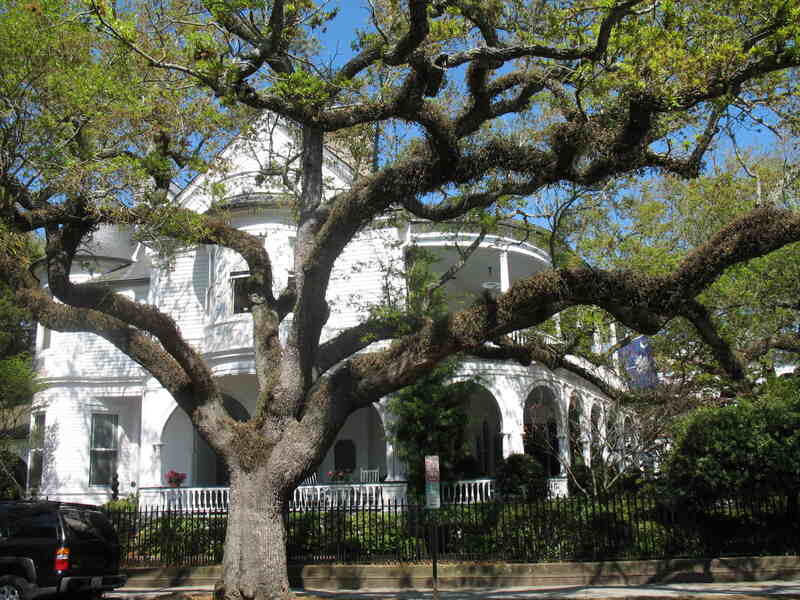
Photo Credit: Spencer Means / Flickr / CC BY-SA 2.0
When a hurricane blows through, it’s crucial to have a hurricane-resistant landscape that includes wind-resistant trees. These trees have strong and deep roots, low centers of gravity, and sturdy trunks. This makes them less likely to get knocked down by high-speed winds and become a hazard to your property or neighbors.
Not all trees are the same, and some species are more susceptible to wind damage than others. Choosing the right trees is essential when creating a hurricane-resistant landscape. Some of the best tree species with high wind resistance include:
- American fringe tree (Chionanthus virginicus)
- Bald cypress (Taxodium distichum)
- Eastern red cedar (Juniperus virginiana)
- Eastern redbud (Cercis canadensis)
- Flowering dogwood (Cornus florida)
- Red maple (Acer rubrum)
- Sabal palmetto (Sabal jamesiana)
- Southern live oak (Quercus virginiana)
- Southern magnolia (Magnolia grandiflora)
- Yaupon holly (Ilex vomitoria)
On the other hand, some trees are more prone to wind damage, and it’s best to avoid planting them in hurricane-prone areas. The University of Florida IFAS Extension recommends to avoid these trees:
- Chinese elm
- Laurel oak
- Sand pine
- Water oak
Estimated Cost: Professional tree planting services can cost anywhere from $22 to $3,300, depending on factors such as the tree species, size, and age. The expenses will be lower for a tiny sapling compared to a large, mature tree.
4. Install a Backyard Buffer
Living close to the ocean is a dream come true for many homeowners. However, it can have its downsides, especially during the rainy season when flooding and erosion can cause significant damage to your property. Installing a backyard buffer can be the ideal solution to protect your property and waterways while providing an attractive natural setting in your backyard.
A backyard buffer, also known as a shoreline buffer or riparian buffer, is a strip of plants consisting of trees, shrubs, and flowers that separates your backyard from the shore. These elements work together to absorb and slow down wind and water during a hurricane, preventing the full force of the storm from reaching your home.
Mulch is another essential element of a backyard buffer. It can help to absorb rainfall and prevent runoff that could lead to flooding. Additionally, a thick layer of mulch can prevent soil erosion and protect the roots of your plants and trees.
Installing a backyard buffer has many ecological and economic benefits, making it an essential part of your property’s landscape.
- Boosts property value
- Lessens the chance of erosion
- Protects waterways from overheating
- Supports wildlife by serving as natural habitat
- Reduces risk of property damage from tropical storms and flood
- Helps reduce noise pollution
- Provides privacy
- Offers shade
When creating your backyard buffer, choose native plants that are well-suited for the area. Remember to plant trees and shrubs that can withstand high winds and heavy rains.
Plants with strong roots, such as bald cypress and live oak, are excellent choices for a backyard buffer. These trees can help keep the soil in place and prevent erosion during a tropical storm. In addition to trees, shrubs such as wax myrtle and firebush can create a buffer zone around your home. These plants have deep roots and require minimal maintenance.
To get started, consult with local nurseries, gardening centers, or environmental organizations for expert tips on installing backyard buffers for the South Carolina Lowcountry.
Estimated Cost: The total cost of creating a backyard buffer is influenced by several factors, such as the selection of plants you intend to install and the size of the buffer zone. Typically, small native perennials can cost between $4 to $25 each, while the cost of planting a tree varies between $22 and $3,300.
5. Plan Tree Placements Away From Your House and Power Lines
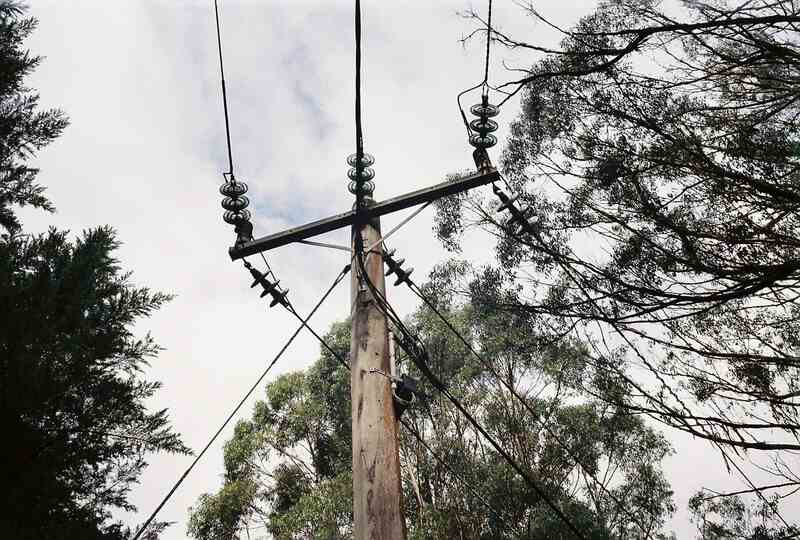
Photo Credit: Matthew Paul Argall / Flickr / CC BY 2.0
When planting trees in your yard, always consider where you place them. Trees can provide shade and beauty to your property, but if planted too close to your home or power lines, they can cause serious damage during a storm.
To avoid this, plan your tree placements carefully. Consider the full size of the tree at maturity and its root system when selecting a spot. You want to ensure the tree won’t interfere with nearby buildings, power lines, or other infrastructure.
Here are some advantages of keeping trees away from structures:
- Reduces the risk of property damage: If a tree falls during a storm, it’s more likely to cause damage to your home if it’s planted too close.
- Prevents power outages: Trees that are planted too close to power lines can cause outages when they fall or sway in high winds.
- Reduces maintenance costs: Trees that are too close to buildings or power lines may require more frequent pruning and maintenance, which can be costly and time-consuming.
Consider these recommendations for safe and effective tree placement:
- Always contact 811 before digging to obtain information about utility lines in your area. Avoid planting trees directly above these lines and opt for shrubs to be on the safe side.
- When planting near power lines, it’s best to avoid trees altogether and choose tall grasses or shrubs instead.
- If you’re planting a large tree, keep it at least 12 feet away from utility lines.
- To prevent future damage, plant trees away from your home’s foundation. Allow at least 5 feet of space between your home and the tree’s mature width (For example, if the tree’s mature width is 20 feet, plant it at least 25 feet away from your foundation).
- When planting small trees near your driveway, ensure they do not have low-hanging branches that could fall and damage your car and garage door.
- Do not plant trees close to or above septic systems or drain fields, as tree roots may damage the system over time.
- When planting multiple trees, take into account their mature width and height to determine how much space you need to leave between them.
Estimated Cost: When transplanting trees, the size of the tree will affect the cost. But it typically falls within the range of $158 to $880. And if you need tree removal services, it will cost you between $347 and $1,117 per tree.
6. Group Trees Together
Even trees know how to party. Planting trees in clusters of five or more can enhance their resistance to high winds by more than 10%, which can offer better protection for your home when hurricane season arrives. Besides, having five diverse trees, each with distinct visual appeal and height, will increase your property’s curb appeal.
Keep in mind, though, that planting trees in a straight line is not the way to go. According to the University of Florida, planting trees in a natural, unforced arrangement, with each tree within 10 feet of the other, can form a robust and sustainable windbreak.
Advantages of grouping trees:
- Makes your lawn look more beautiful
- Increases the trees’ resistance to wind
- Can help reduce cooling and heating costs
Estimated Cost: Tree prices can fluctuate greatly, from a relatively low $150 to $1,850 or more, depending on the species and size of the tree. Purchasing trees or saplings in large quantities may reduce the price per tree. Plus, the cost of having a professional install five trees will typically be lower per tree than installing a single tree.
7. Choose Native and Salt-Tolerant Plants
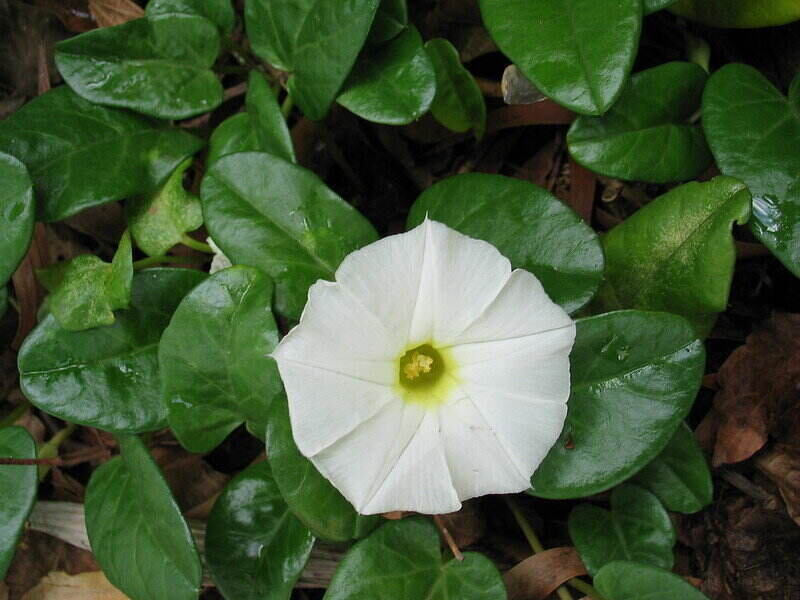
Photo Credit: David Eickhoff / Flickr / CC BY 2.0
When you live near the coast, maintaining a healthy lawn in salty coastal air can be challenging. Saltwater spray and salty soil can damage plants that are not suited for the environment, so it’s important to choose native and salt-tolerant plants.
Native plants have already adapted to local environmental conditions and have evolved to survive in the specific climate and soil of a region. Salt-tolerant plants are able to thrive in areas with high salt content in the soil and air, making them ideal for coastal landscapes.
Choosing salt-tolerant and native plants has several benefits, including reducing the need for fertilizer and pesticides, which can harm the environment. These plants also require less watering and maintenance, which saves time and money.
Some popular native and salt-tolerant plants for coastal landscapes recommended by Clemson Extension include:
- Adam’s needle (Yucca filamentosa)
- American beachgrass (Ammophila breviligulata)
- American beautyberry (Callicarpa americana)
- American holly (Ilex opaca)
- Beach evening primrose (Oenothera drummondii)
- Coastal sweet pepperbush (Clethra alnifolia)
- Gulf muhly (Muhlenbergia capillaris)
- Sea oats (Uniola paniculata)
- Scarlet beebalm (Monarda didyma)
- Southern wax myrtle (Myrica cerifera)
- Wild olive (Osmanthus americanus)
Estimated Cost: If you’re looking for small, salt-tolerant perennials, the South Carolina Native Plant Society’s Lowcountry plant sale offers them at prices ranging from $4 to $25. And if you want a professional to install a flower bed for you, it can cost anywhere from $585 to $3,300.
8. Use Soft, Organic Mulch for Your Garden Beds
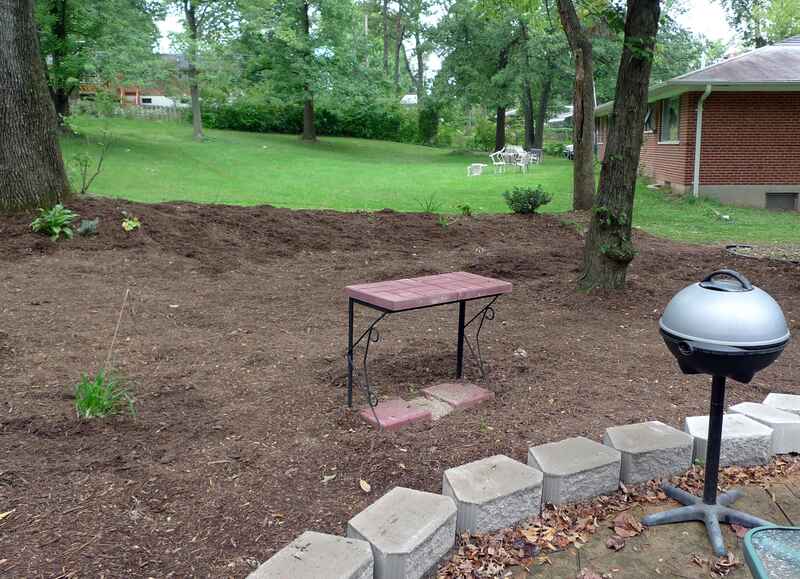
Photo Credit: christina rutz / Flickr / CC BY 2.0
As you prepare your yard for hurricane season, don’t forget about your garden beds. While mulch is a necessary component of any healthy garden, not all mulch is created equal. In areas like Charleston that experience high winds, it’s important to choose soft, organic mulches that won’t turn into dangerous projectiles during a storm.
Examples of soft, organic mulch:
- Decomposing leaves
- Pine needles
- Shredded bark
- Wood chips
Not only do organic mulches stay in place better than hard mulches like stones, river rock, pea gravel, and pebbles, but they also offer a host of benefits to your plants. Organic mulches help retain moisture in the soil, suppress weed growth, and provide insulation to plant roots during temperature fluctuations.
One important consideration when choosing organic mulch is to avoid anything that could potentially harbor disease or pests. For that reason, you should avoid using the following:
- Freshly cut grass clippings: They can generate heat and invite harmful organisms.
- Straw or hay: While it may be tempting to use them as mulch, they can contain weed seeds that will proliferate in your garden beds.
Estimated Cost: The cost of shredded bark mulch is roughly $65 per cubic yard, while aged wood chips typically cost around $70 per cubic yard. However, you can obtain fresh wood chips at no cost from a tree recycling center or your local arborist. Alternatively, you can create your own nutrient-rich mulch by composting leaves at home.
9. Perform Regular Landscape Maintenance
Regular maintenance ensures that your lawn, garden, and trees stay healthy and resilient, even in the face of extreme weather. You should stay vigilant throughout the year, but especially in the months leading up to hurricane season.
Inspect Your Trees
One crucial aspect of landscape maintenance is inspecting your trees. Check for any signs of damage or disease, such as:
- Cracks in the trunk
- Dead branches
- Yellowing leaves
Addressing these issues early on can prevent more serious problems down the line, as even a relatively small amount of wind can cause weak or dying trees to topple over.
To make sure you’re identifying all the hazardous trees on your property, it’s a good idea to hire a qualified arborist to inspect them. They’ll be able to identify any trees that pose a risk, and together you can develop a plan to remove them safely.
Prune and Trim Trees
Strong winds can easily break tree branches, causing damage to your property. A long branch hanging over your roof might look harmless, but it could be a potential storm hazard. A hurricane can snap it off like a twig, causing major damage to your home.
To avoid such scenarios, it’s important to prune and trim back any weak or overgrown branches. This will help ensure your plants are at their healthiest when a storm comes rolling in. You don’t want any branches breaking through your windows, damaging your car, or injuring anyone.
Maintain Your Yard
In addition to tree maintenance, regularly mow your lawn, weed your garden beds, and remove any debris to prevent potential hazards from flying around during high winds. It’s also a good idea to regularly fertilize your lawn and garden to keep your plants healthy and strong.
Estimated Cost: Trimming trees typically costs between $227 and $708, while hedge trimming can cost between $56 and $85 per hour, and bush trimming can range from $7 to $24 per bush or $45 to $75 per hour. If you’re looking to save money, you can trim small plants yourself, but it’s best to leave the trimming of large trees to the professionals.
10. Clear Storm Drain Paths
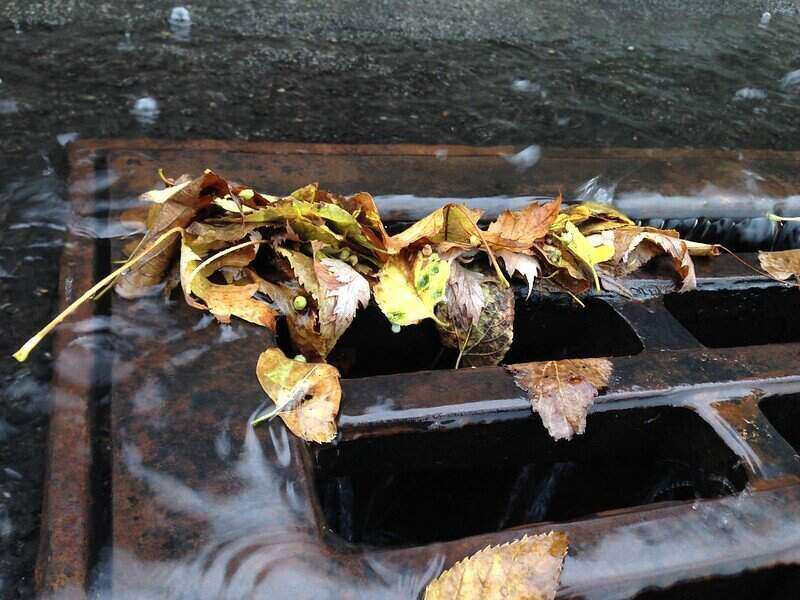
Photo Credit: Dan Keck / Flickr / Public Domain
Although you cannot control the rain, you can take steps to ensure that it doesn’t cause damage to your lawn or home. Avoid getting your drain clogged, as it could lead to flooding and other problems. To prevent flooding and other issues caused by stormwater, it should flow easily away from your lawn and toward the storm drain.
Be sure to:
- Clean your gutters
- Inspect your downspouts
- Clear out your storm drain
- Remove any landscaping features that might block the flow of water
- Pick up any debris, such as leaves, rocks, or branches from your lawn
Even standing water, or puddling, can be dangerous, as it can weaken roots and cause trees to fall during storms. Be sure to take all necessary precautions to keep your lawn and property safe from stormwater damage.
A great way to avoid water pooling in your sloped yard is to install a French drain. This way, the water that collects in your yard will be redirected through the drainpipe and flow away from your home.
Estimated Cost: The cost of yard cleanup services ranges from $154 to $411 on average, but prices can vary significantly based on the amount of work needed. For more extensive yard cleanup, you may end up paying up to $1,059. On the other hand, installing a French drain can cost between $500 and $18,000, depending on the size of your yard and the complexity of the installation.
Protect Your Charleston Home Before a Hurricane Strikes
Since Charleston is one of the top cities most vulnerable to hurricane damage, you should always heed storm warnings, stay updated on weather forecasts, and take steps to protect your home before a hurricane strikes. By doing so, you can minimize the potential for damage and ensure the safety of your family and property.
While you’re monitoring weather.gov for storm updates, the following tips can help you get prepared:
- Evaluate your home’s exterior and identify areas vulnerable to high winds or flooding.
- Check your roof, siding, windows, and doors for any signs of damage or weakness.
- Address any areas of concern before a hurricane strikes. This may involve reinforcing your roof or installing impact-resistant windows and doors.
- Prepare your yard by securing loose items that could become projectiles during high winds. This includes patio furniture, potted plants, and outdoor decor.
- Inspect your roof for loose shingles or metal sheets that could potentially fall on your home or power lines.
- Clean your downspouts and gutters to prevent water damage.
- Have an emergency kit on hand. Your kit should include essentials such as water, non-perishable food, first aid supplies, and flashlights.
- Also, have a plan for communicating with family members, ensuring the safety of pets, and knowing where to go if you need to evacuate.
FAQ About Hurricane-Resistant Landscaping Ideas
Generally, hurricane season runs from June 1 to Nov. 30, with the peak of the season occurring from mid-August to late October. During this time, the warm waters of the Atlantic and Gulf of Mexico provide the ideal conditions for hurricanes to form and intensify.
Due to its location on the South Carolina coast, Charleston has been hit by numerous powerful hurricanes in the past, including Hurricane Hugo in 1989 and Hurricane Matthew in 2016. However, the frequency of hurricanes in the area can vary from year to year.
On average, Charleston is affected by a hurricane once every 10 years, with major hurricanes occurring less frequently. But keep in mind that this is just an average and that there is always the potential for a hurricane to make landfall any time during hurricane season.
Zoysiagrass is one of the best hurricane-resistant grasses. This warm-season grass is known for its ability to withstand high winds. It’s also low-maintenance and has good salt tolerance, making it a great choice for homes along the South Carolina coast.
Another option to consider is St. Augustinegrass, which is indigenous to coastal regions. This warm-season grass is known for its ability to thrive in hot, humid conditions. It’s a hardy grass with good salt tolerance that can tolerate heavy foot traffic and rough weather conditions.
Protect Your Home With Hurricane-Resistant Landscaping
Despite the unpredictable nature of hurricanes, there are steps you can take to prepare for these storms. Creating hurricane-resistant landscaping is an essential aspect of storm preparedness. From selecting the right native plants and trees to installing backyard buffers and seawalls, you need to take the time and plan ahead.
Reach out to a Charleston landscaping pro today for help in making your landscape not only beautiful but also resilient and able to withstand the storms that may come your way.
Main Image Credit: Wallpaperflare